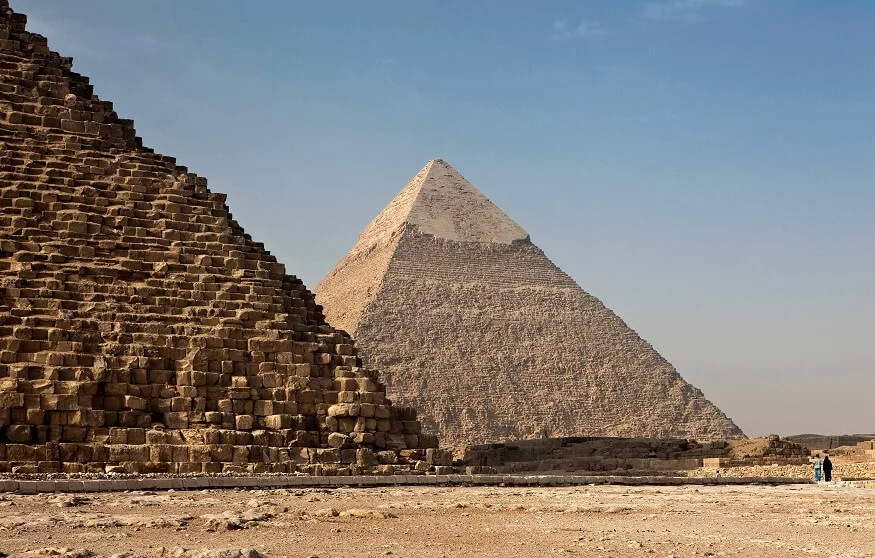The towering structures of ancient pyramids have captivated human imagination for centuries, standing as timeless witnesses to the ingenuity of ancient civilisations. Let’s delve into the history of pyramids, explore interesting facts surrounding these architectural marvels, and unravel the methods employed in preserving these ancient wonders
History of Pyramids
The history of pyramids is a tapestry woven with the threads of ancient cultures, each contributing to the rich narrative of these enigmatic structures. While most associate pyramids with ancient Egypt, pyramid-building was not exclusive to the Nile Valley. Mesopotamia, Mesoamerica, and even Sudan witnessed the construction of pyramidal structures, each with its unique architectural style and purpose.
In Egypt, the Giza Plateau is home to the most iconic pyramids – the Great Pyramid of Khufu, the Pyramid of Khafre, and the Pyramid of Menkaure. These colossal structures were built during the Old Kingdom period, around 2580–2560 BC. Theories about the purpose of these pyramids abound, ranging from religious significance to astronomical alignment, but the exact purpose remains a subject of scholarly debate.
Interesting Facts about Pyramids
Here are some interesting facts about pyramids that kids would love to read
- Pyramids are not exclusive to Egypt; they have been built by various ancient cultures worldwide, including Mesopotamia, Mesoamerica, and Sudan.
- The Great Pyramid of Giza is incredibly precise in its construction. The sides are aligned with the cardinal points of the compass, and the ratio of its circumference to its height is remarkably close to the mathematical constant pi.
- The Great Pyramid of Khufu held the title of the tallest man-made structure for over 3,800 years, standing at an impressive height of 146.6 metres (481 feet) until the construction of the Lincoln Cathedral in 1311.
- Contrary to popular belief, evidence suggests that the pyramid builders were skilled labourers and not slaves. Records indicate a workforce of well-fed workers who were likely respected for their craft.
- The exact methods used to construct pyramids remain a subject of debate. Theories include the use of sledges, ramps, and levers, but no definitive method has been universally accepted.
- Some pyramids, particularly those in Egypt, are aligned with remarkable precision to specific celestial bodies. This suggests a deep connection between pyramid construction and astronomical observations.
- Pyramids are not just external structures; they contain intricate internal chambers and passageways. The purpose of these chambers varies, with theories ranging from burial sites to symbolic representations of the afterlife.
- The Bent Pyramid in Dahshur, Egypt, is unique due to its change in slope. Believed to be an attempt to reduce the structural stress, it gives the pyramid a distinct bent appearance.
- The study of hieroglyphs on pyramid walls has been instrumental in understanding ancient Egyptian life, religion, and beliefs. Hieroglyphs serve as a historical record and offer insights into the purpose of the pyramids.
- Recent discoveries include hidden chambers, artefacts, and evidence of the pyramid builders’ lives, shedding light on the mysteries of these ancient structures.
Preserving the Pyramids
Several methods have been employed to protect and conserve the pyramids:
Restoration Efforts: Ongoing restoration projects aim to repair damage caused by centuries of erosion, earthquakes, and human activity. Modern technologies, such as 3D scanning and computer-aided design, are used to create accurate models for restoration work.
Environmental Controls: The climate and environmental conditions surrounding the pyramids play a crucial role in their preservation. Measures are taken to control humidity, temperature, and pollution to mitigate the impact on the ancient structures.
Tourism Management: The influx of tourists to pyramid sites is both a blessing and a challenge. Strict regulations and visitor management strategies are implemented to minimise the impact of foot traffic on the structures. Restricted access to certain areas helps preserve the integrity of the pyramids.
Protection of Pyramids: Security measures are implemented to protect these archaeological wonders from both external threats and the potential for illegal trade in antiquities.
Surveillance Systems: State-of-the-art surveillance systems, including cameras, sensors, and security personnel, are deployed to monitor pyramid sites around the clock. This not only deters potential vandals but also helps authorities respond swiftly to any security breaches.
Heritage Legislation: Legislation and international agreements are in place to protect archaeological sites, including pyramids. Legal frameworks aim to deter illegal excavation and trade of antiquities, with severe penalties for those involved in such activities.
Community Engagement: Involving local communities in the protection and preservation of pyramids is crucial. Empowering communities through education and awareness campaigns fosters a sense of pride and responsibility, reducing the likelihood of vandalism or illegal activities.
Myths about Pyramids for Kids
Now, let’s embark on a journey into the realm of imagination and explore some whimsical myths about pyramids tailored for young minds.
- The Pyramid Puzzle: Legend has it that each stone in the pyramid holds a piece of a magical puzzle. When assembled correctly, it reveals the location of a hidden treasure.
- The Labyrinth of Lost Time: Inside the pyramid, a mystical labyrinth exists where time stands still. Anyone who enters might find themselves in a different era, experiencing the wonders of ancient civilisations.
- The Sphinx’s Riddles: The Sphinx is known for posing riddles to those who seek its wisdom. Only the cleverest adventurers can answer the riddles and unlock the secrets of the pyramid.
- Moonlight Whispers: During full moons, the pyramid stones come to life, sharing ancient stories with those who camp near the pyramids.
- The Echoing Voices: It is said that if you shout a question inside the pyramid, the ancient spirits residing within will answer. The catch is that the answer is in the form of an echoing riddle.
- The Staircase to the Stars: Hidden within the pyramid is a staircase that leads to the stars. Only those who climb it under a meteor shower will be transported to a cosmic playground.
- The Pygmy Pharaoh’s Secret Room: A tiny door in one of the pyramid chambers opens to a room where a miniature pharaoh reigns. The miniature ruler grants wishes to those who discover the door.
- The Ancestor’s Dance: On the anniversary of the pyramid’s completion, the spirits of ancient builders emerge to dance around the structure, celebrating their timeless achievement.
- The Guardian Scarab: A giant golden scarab beetle guards the entrance to the pyramid, allowing only those with pure intentions to enter. It bestows luck upon those deemed worthy.
- The Time-Travelling Camel: A mystical camel resides near the pyramid, and anyone who rides it is transported through time. The camel’s hump hides a map that guides adventurers on historical journeys.










